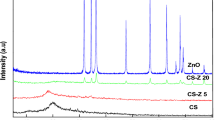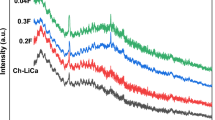Abstract
We report, for the first time, a one-step hydrothermal (HT) process to design and synthesize water-dispersible chitosan nanoparticles loaded with mixed valence copper. Interestingly, this HT copper-chitosan biocompatible composite exhibits exceptionally high antimicrobial properties. A comprehensive characterization of the composite indicates that the hydrothermal process results in the formation of monodispersed nanoparticles with average size of 40 ± 10 nm. FT-IR and Raman spectroscopic studies unveiled that the hydrolysis of the glycoside bonds as the origin of the depolymerization of chitosan. Furthermore, X-Ray Photoelectron Spectroscopy measurements confirmed the presence of mixed valence copper states in the composite, while UV–Vis and FT-IR studies revealed the chemical interaction of copper with the chitosan matrix. Hence, the extensive spectroscopic data provide strong evidence that the chitosan structure was rearranged to capture copper oxide nanoparticles. Finally, HT copper-chitosan composite showed a complete killing effect when tested against both Gram negative (E. coli) and Gram positive (S. aureus) bacteria at metallic copper concentration of 100 μg/ml (1.57 mM). At the same concentration, neither pure chitosan nor copper elicited such antimicrobial efficacy. Thus, we show that HT process significantly enhances the synergistic antimicrobial effect of chitosan and copper in addition to increasing the water dispersibility.






Similar content being viewed by others
References
Akopova TA, Zelenetskii AN, Ozerin AN (2011) In: Ferguson AN, O’Neill AG (eds) Focus on chitosan research, chap 8. Nova Science Publishers, New York
Beamson GBD (1992) High resolution XPS of organic polymers: the Scienta ESCA300 database. Wiley, Chichester, New York
Borkow G, Gabbay J (2005) Copper as a biocidal tool. Curr Med Chem 12:2163–2175
Briggs D, Seah P (1994) Practical surface analysis: auger and X-ray photoelectron spectroscopy. Wiley, Chichester
Brugnerotto J, Lizardi J, Goycoolea FM, Arguelles-Monal W, Desbrieres J, Rinaudo M (2001) An infrared investigation in relation with chitin and chitosan characterization. Polymer 42:3569–3580. doi:10.1016/S0032-3861(00)00713-8
Brunel F, El Gueddari NE, Moerschbacher BM (2013) Complexation of copper(II) with chitosan nanogels: toward control of microbial growth. Carbohydr Polym 92:1348–1356. doi:10.1016/j.carbpol.2012.10.025
Chen J-Y, Zhou P-J, Li J-L, Li S-Q (2007) Depositing Cu2O of different morphology on chitosan nanoparticles by an electrochemical method. Carbohydr Polym 67:623–629. doi:10.1016/j.carbpol.2006.07.003
de Godoi FC, Rodriguez-Castellon E, Guibal E, Beppu MM (2013) An XPS study of chromate and vanadate sorption mechanism by chitosan membrane containing copper nanoparticles. Chem Eng J 234:423–429. doi:10.1016/j.cej.2013.09.006
Ding SJ, Zhang QQ, Zhang DW, Wang JT, Lee WW (2001) Copper metallization of low-dielectric-constant a-SiCOF films for ULSI interconnects. J Phys Condens Matter 13:6595–6608. doi:10.1088/0953-8984/13/31/301
Du W-L, Xu Y-L, Xu Z-R, Fan C-L (2008) Preparation, characterization and antibacterial properties against E-coli K(88) of chitosan nanoparticle loaded copper ions. Nanotechnology. doi:10.1088/0957-4484/19/8/085707
Gouda M, Hebeish A (2010) Preparation and evaluation of CuO/Chitosan nanocomposite for antibacterial finishing cotton fabric. J Ind Text 39:203–214. doi:10.1177/1528083709103142
Han X-Y, Du W-L, Huang Q-C, Xu Z-R, Wang Y-Z (2012) Changes in small intestinal morphology and digestive enzyme activity with oral administration of copper-loaded chitosan nanoparticles in rats. Biol Trace Elem Res 145:355–360. doi:10.1007/s12011-011-9191-x
Hans M, Erbe A, Mathews S, Chen Y, Solioz M, Mucklich F (2013) Role of copper oxides in contact killing of bacteria. Langmuir 29:16160–16166. doi:10.1021/la404091z
Hu XL, Shi PF, Xu XY, Yin FJ, Yang Q, Wang DQ (2010) Synthesis, structure and property of mixed-valence tetranuclear copper complex [Cu2L2]center dot[Cu(pht)(2)](2). Acta Chim Sinica 68:487–492
Huang H, Liu F, Chen S, Zhao Q, Liao B, Long Y, Zeng Y, Xia X (2013) Enhanced fluorescence of chitosan based on size change of micelles and application to directly selective detecting Fe(3)(+) in human serum. Biosens Bioelectron 42:539–544. doi:10.1016/j.bios.2012.10.098
Liu C, Zhang H, Tang Y, Luo S (2014) Controllable growth of graphene/Cu composite and its nanoarchitecture-dependent electrocatalytic activity to hydrazine oxidation. J Mater Chem A 2:4580–4587. doi:10.1039/C3TA14137C
Macomber L, Imlay JA (2009) The iron-sulfur clusters of dehydratases are primary intracellular targets of copper toxicity. Proc Natl Acad Sci USA 106:8344–8349. doi:10.1073/pnas.0812808106
Mahmood W (2011) Evidence of Cu(II) Ion interaction in crosslinked chitosan thin film from X-ray photoelectron spectroscopy and field emission scanning electron microscopy. J Mater Sci Eng B5:584–590
Mao S, Shuai X, Unger F, Simon M, Bi D, Kissel T (2004) The depolymerization of chitosan: effects on physicochemical and biological properties. Int J Pharm 281:45–54. doi:10.1016/j.ijpharm.2004.05.019
Miya M, Iwamoto R, Yoshikawa S, Mima S (1980) Ir spectroscopic determination of conh content in highly deacylated chitosan. Int J Biol Macromol 2:323–324. doi:10.1016/0141-8130(80)90056-2
Myneni SCB, Traina SJ, Waychunas GA, Logan TJ (1998) Vibrational spectroscopy of functional group chemistry and arsenate coordination in ettringite. Geochim Cosmochim Acta 62:3499–3514. doi:10.1016/S0016-7037(98)00221-X
Pennings PS (2013) HIV drug resistance: problems and perspectives. Infect Dis Rep 5:e5. doi:10.4081/idr.2013.s1.e5
Perez VG, Waguespack AM, Bidner TD, Southern LL, Fakler TM, Ward TL, Steidinger M, Pettigrew JE (2011) Additivity of effects from dietary copper and zinc on growth performance and fecal microbiota of pigs after weaning. J Anim Sci 89:414–425. doi:10.2527/jas.2010-2839
Pettit RK, Weber CA, Kean MJ, Hoffmann H, Pettit GR, Tan R, Franks KS, Horton ML (2005) Microplate Alamar blue assay for Staphylococcus epidermidis biofilm susceptibility testing. Antimicrob Agents Chemother 49:2612–2617. doi:10.1128/AAC.49.7.2612-2617.2005
Poulston S, Parlett PM, Stone P, Bowker M (1996) Surface oxidation and reduction of CuO and Cu2O studied using XPS and XAES. Surf Interface Anal 24:811–820. doi:10.1002/(sici)1096-9918(199611)24:12<811:aid-sia191>3.0.co;2-z
Qu X, Wirsen A, Albertsson AC (2000) Effect of lactic/glycolic acid side chains on the thermal degradation kinetics of chitosan derivatives. Polymer 41:4841–4847. doi:10.1016/S0032-3861(99)00704-1
Ratner BD, Castner DG (2009) Electron spectroscopy for chemical analysis. Wiley & Sons Ltd, Chichester, pp 47–112
Shukla SK, Mishra AK, Arotiba OA, Mamba BB (2013) Chitosan-based nanomaterials: a state-of-the-art review. Int J Biol Macromol 59:46–58. doi:10.1016/j.ijbiomac.2013.04.043
Souli M, Galani I, Plachouras D, Panagea T, Armaganidis A, Petrikkos G, Giamarellou H (2013) Antimicrobial activity of copper surfaces against carbapenemase-producing contemporary Gram-negative clinical isolates. J Antimicrob Chemother 68:852–857. doi:10.1093/jac/dks473
Thompson K, Burkholder K, Patterson J, Applegate TJ (2008) Microbial ecology shifts in the ileum of broilers during feed withdrawal and dietary manipulations. Poult Sci 87:1624–1632. doi:10.3382/ps.2007-00324
Usman MS, Ibrahim NA, Shameli K, Zainuddin N, Yunus WMZW (2012) Copper nanoparticles mediated by chitosan: synthesis and characterization via chemical methods. Molecules 17:14928–14936. doi:10.3390/Molecules171214928
Warnes SL, Green SM, Michels HT, Keevil CW (2010) Biocidal efficacy of copper alloys against pathogenic enterococci involves degradation of genomic and plasmid DNAs. Appl Environ Microbiol 76:5390–5401. doi:10.1128/AEM.03050-09
Warnes SL, Caves V, Keevil CW (2012) Mechanism of copper surface toxicity in Escherichia coli O157:H7 and Salmonella involves immediate membrane depolarization followed by slower rate of DNA destruction which differs from that observed for Gram-positive bacteria. Environ Microbiol 14:1730–1743. doi:10.1111/j.1462-2920.2011.02677.x
Weaver L, Noyce JO, Michels HT, Keevil CW (2010) Potential action of copper surfaces on meticillin-resistant Staphylococcus aureus. J Appl Microbiol 109:2200–2205. doi:10.1111/j.1365-2672.2010.04852.x
Xiao Z, Jin S, Pang M, Liang C (2013) Conversion of highly concentrated cellulose to 1,2-propanediol and ethylene glycol over highly efficient CuCr catalysts. Green Chem 15:891–895. doi:10.1039/c3gc40134k
Zheng Y, Yi Y, Qi YP, Wang YT, Zhang WA, Du M (2006) Preparation of chitosan-copper complexes and their antitumor activity. Bioorg Med Chem Lett 16:4127–4129
Acknowledgments
This project was partly supported by Grants from National Science Foundation CBET (Award #1159500) and Citrus Research and Development Foundation (Grants # 328, #196, # 554). Authors acknowledge Dr. Andre Gesquiere at UCF NanoScience Technology Center for his valuable suggestions on characterization of HT chitosan material. We would like to thank the staff of Advanced Materials Processing and Analysis Center (AMPAC) and Materials Characterization Facility (MCF) at the Univeristy of Central Florida for their technical support.
Author information
Authors and Affiliations
Corresponding author
Additional information
Srijita Basumallick and Parthiban Rajasekaran have equally contributed to this work.
Rights and permissions
About this article
Cite this article
Basumallick, S., Rajasekaran, P., Tetard, L. et al. Hydrothermally derived water-dispersible mixed valence copper-chitosan nanocomposite as exceptionally potent antimicrobial agent. J Nanopart Res 16, 2675 (2014). https://doi.org/10.1007/s11051-014-2675-9
Received:
Accepted:
Published:
DOI: https://doi.org/10.1007/s11051-014-2675-9




